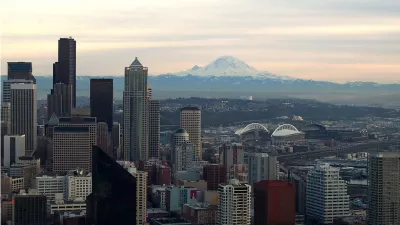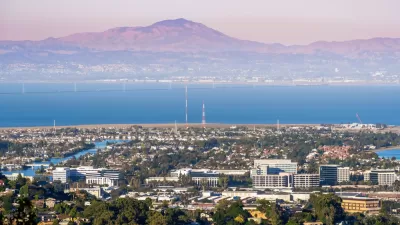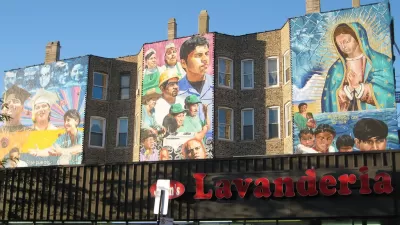Urban growth is slowing and suburban and beyond growth is increasing according to this Wall Street Journal article. But wait—didn’t we just post an article from Governing that concluded just the opposite from the same Census data released May 22?

"After two years of solid urban growth, more Americans are moving again to suburbs and beyond," writes Neil Shah who "covers the U.S. economy and demographics from The Wall Street Journal's New York office."
"Fourteen of the nation's 20 biggest cities saw their growth slow or their populations fall outright in 2012-2013 compared with 2011-2012," Shah continues in his article that appears to contradict yesterday's post from Governing, "New Census Data Highlight Continued Growth of Urban Areas". "A year earlier, 17 of the nation's 20 largest cities showed faster population growth than the previous year," he adds.
Upon closer examination of The Wall Street Journal piece, it becomes apparent that the main message is that urban growth is slowing compared to last year, while suburban growth is on the upswing, but the change is minor.
In some cases, fast-growing cities are slowing down: Austin's growth rate decreased from 3.1% to 2.4%. In other instances, slower-growing cities grew at an even more diminished pace: New York's rate decreased to 0.7% from 0.9%.
Shah does set the record straight in term of which sector is growing faster. "Overall, cities are still growing slightly faster than the suburbs—a historical anomaly after decades of American migration to the burbs," he adds as if to indicate that it is an anomaly that time will soon correct.
In the news video, "Americans Returning to Lawns and Picket Fences", Shaw is interviewed by the Journal's MoneyBeat Reporter, Paul Vigna. In response to Vigna's first question, "How stark are the numbers?" Shaw states that "it's early", and that they are "preliminary signs of change."
Shaw interprets the slight but noticeable change in the data as a sign that the economy is on the upswing, allowing people to move to the suburbs and exurbs again, particularly for young families, as the one he cites who sold their Chicago condo and moved to suburban Deerfield.
When in doubt, it's always good to quote demographic experts, particularly the ones cited here frequently.
"City growth may be bottoming out, as well as the downsizing of the outer suburbs," William H. Frey, a demographer at the Brookings Institution, said. He said it remains unclear "whether the city slowdown signals a return to renewed suburban growth."
Shaw barely mentions why cities have been growing faster. He acknowledges urban preferences in only one statement: "Some of the growth has been fueled by younger Americans and retirees preferring city life, either for life-style reasons or to downsize their living arrangements." After all, he covers economics, not urbanism. Nonetheless, it will be interesting to see future demographic data to see where the dominant growth occurs.
"The slowing growth in these urban cores and the increasing gains in the suburbs may be the first indication of a return to more traditional patterns of city-suburban growth," said Ken Johnson, a demographer at the University of New Hampshire.
Readers may be interested in reading a direct counter to Shaw's piece by James A. Bacon in Bacon's Rebellion. "The editor’s treatment of the story... is highly misleading...The issue is important because it bears upon the debate over the future of metropolitan development...," writes Bacon.
FULL STORY: Signs of a Suburban Comeback

Alabama: Trump Terminates Settlements for Black Communities Harmed By Raw Sewage
Trump deemed the landmark civil rights agreement “illegal DEI and environmental justice policy.”

Study: Maui’s Plan to Convert Vacation Rentals to Long-Term Housing Could Cause Nearly $1 Billion Economic Loss
The plan would reduce visitor accommodation by 25% resulting in 1,900 jobs lost.

Planetizen Federal Action Tracker
A weekly monitor of how Trump’s orders and actions are impacting planners and planning in America.

Restoring Northern India’s Himalayan ‘Water Temples’
Thousands of centuries-old buildings protect the region’s natural springs and serve as community wells and gathering places.

Milwaukee to Double Bike Share Stations
Bublr Bikes, one of the nation’s most successful, will add 500 new e-bikes to its system.

DC Extends Application Window for Outdoor Dining Permits
District restaurants will have until the end of November to apply, but businesses with permits in rush hour parking lanes must end operations on July 31.
Urban Design for Planners 1: Software Tools
This six-course series explores essential urban design concepts using open source software and equips planners with the tools they need to participate fully in the urban design process.
Planning for Universal Design
Learn the tools for implementing Universal Design in planning regulations.
Caltrans
Smith Gee Studio
Institute for Housing and Urban Development Studies (IHS)
City of Grandview
Harvard GSD Executive Education
Toledo-Lucas County Plan Commissions
Salt Lake City
NYU Wagner Graduate School of Public Service





























